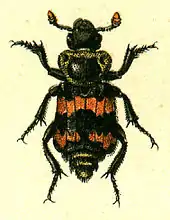| Nicrophorus vestigator | |
|---|---|
 | |
| Nicrophorus vestigator. Museum specimen | |
| Scientific classification | |
| Kingdom: | |
| Phylum: | |
| Class: | |
| Order: | |
| Family: | |
| Subfamily: | |
| Tribe: | |
| Genus: | |
| Species: | N. vestigator |
| Binomial name | |
| Nicrophorus vestigator Herschel, 1807 | |
| Synonyms | |
| |
Nicrophorus vestigator is a species of beetle belonging to the family Silphidae.
Description

Nicrophorus vestigator can reach a length of about 14–22 millimetres (0.55–0.87 in). The basic color of the body is black, with two wide transversal orange stripes on the elytra. These beetles have large club-like antennae equipped with black and yellow tips. The legs are strong. The last three abdominal segments protrude beyond the elytra.[1]
Like other burying beetles they bury the carcasses of small vertebrates such as birds and mice as a food source for their larvae. Larval development takes place during the summer, and the fully formed individuals can be found mainly in May–June and in August.[1]
Distribution
This species is present in most of Europe, in the eastern Palearctic realm and in the Near East.[2]
Bibliography
- Sikes, Derek S., Ronald B. Madge, and Alfred F. Newton (2002) A catalog of the Nicrophorinae (Coleoptera: Silphidae) of the world, Zootaxa, no. 65
- Baranowski, R. 1982. Intressanta skalbaggsfynd 6. Ent. Tidskr.103: 130–136.
- Hansen, V. 1968. Biller XXV. Adselbiller, stumpbiller m.fl. Danmarks Fauna 77.
- Fabre, J.-H. 1925 Souvenirs Entomologiques Volume 6 Chapitre VII
References